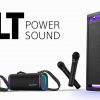In our companion articles, we have covered several TV display technologies including LED/LCD, QLED, NanoCell, Mini-LED, OLED, and QD-OLED. However, that isn’t the end of the story. MicroLED has the potential to offer a superior large screen viewing experience — at a very high cost.

What MicroLED Is
MicroLED is a technology that utilizes microscopic-sized LEDs for displaying images. Each MicroLED pixel contains three subpixels that natively emit red, green, and blue light. The pixels also contain the image information. Each microLED pixel can be brightened, dimmed, or turned on and off.
Conceptually, MicroLED technology is similar to OLED TV technology. However, instead of using organic materials to construct the pixels which are somewhat unstable, MicroLED pixels are inorganic with no stability issues such as color decay over time, screen “burn-in” when static images are displayed for a long time period, or temperature sensitivity that prevents high-brightness display.

MicroLED Display Capabilities
Here is a quick rundown of MicroLED Display features.
- Pure color generation and display. Additional color filtering is not necessary.
- High light output for better HDR support as well as for viewing in both indoor and outdoor settings.
- Wide viewing angle support without significant color and contrast fading.
- Low latency and high refresh rate support without additional motion smoothing/processing such as frame interpolation or black frame insertion.
- 2K, 4K, and 8K resolutions are supported but are screen size dependent. This means that smaller screen sizes may only be available in 2K resolution, while 8K would only be available for extremely large screen sizes.
- 2D and 3D viewing capability at the discretion of the manufacturer.
- Efficient power consumption when compared to other types of TVs with equivalent screen sizes.
Modular Construction
One unique, and innovative feature of MicroLED technology is that modular construction is supported. This means that MicroLED displays or TV can be assembled from smaller modules to create any needed screen size in several aspect ratios.
This is well-suited for commercial applications, such as large digital signage displays or as a video projector/screen replacement in movie theaters.
Tip: Modular construction only supports wall mount installation. For home theater applications, pre-assembled screen sizes are offered, but some are shipped in modules and “assembled on site” by an authorized dealer/installer. Pre-assembled screens may be offered with stand or wall mounting at the discretion of the manufacturer.

Where MicroLED Is Used
MicroLED displays are mainly used in commercial applications but they are also available to consumers for home theater use via special order.
Samsung and CSEED use the term MicroLED, LG uses the marketing label Magnit, and Sony uses Crystal LED. A limited number of cinemas also use MicroLED screens to show movies. Sony’s Crystal LED technology has been used successfully as a green screen replacement in movie and TV show production.

Micro-LED and DVLED
Micro-LED also fits into a larger display category referred to as DVLED (Direct View LED – Direct View Light Emitting Diode).
This category includes video walls and displays you see in stadiums, arenas, other large event venues, and “high-res” billboards (such as the ones scattered around Las Vegas and Times Square in NYC).
Some of these displays use MicroLEDs and some use slightly larger near-Micro LED size light emitting diodes that also generate their own light and color. The near-MicroLEDs are closer to the size of MiniLEDs, which are normally used as backlighting elements of select LED/LCD TVs but have been made with the ability to generate both light and color, thereby functioning as pixels just as their smaller MicroLED cousins.
Tip: Larger near-MicroLEDs are also being offered as home theater options with extremely large screen sizes and very high price tags.

MicroLED And You
The manufacturing cost of MicroLED is very high due to the microscopic precision needed to place MicroLEDs onto a backing surface. If you have deep pockets, you can get one, but it will be several years, or even a decade before you will find DVLED and MicroLED options affordable for the mainstream consumer. That being said, MicroLED and DVDLED video walls could end up becoming commonplace in homes in the not-too-far-distant future.
Related Reading





















































Kevin palmeter
September 3, 2024 at 10:44 pm
Good article, you are correct many are using the “marketing term” Micro LED, but are really providing some form of mini LED, NOT micro LED, in either SMD, FCSMD or Fc-COB. True micro LED is coming but requires new manufacturing technology. mass transfer tech holds promise but still in infancy for a visual creating process. IE the consistency needs to get better. Brightness is key for HDR, I look more at contrast. currently COB is providing very good contrast. The rub? The coating! Some use GOB (glue on board), or encapsulation, these layers cal vary from matte to gloss, consistent or inconsistent in application. Some are prone to de-lamination or distortion over time or with UV exposure in the home. Daktronics has released a line of COB for high end command rooms with solid contrast and lifespan. The line is affordable and priced below their traditional SMD dvLED product.